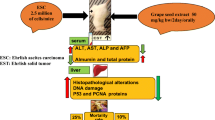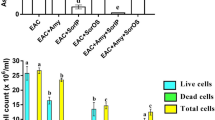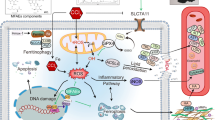Abstract
Vitamin B17 (VB17), also known as amygdalin and laetrile, is a type of carbohydrate occurring naturally in many plants, such as apricot kernels which have obtained a great interest in cancer therapy. This study aimed to investigate the hepatic protective potential of VB17 against Ehrlich ascites carcinoma (EAC)–bearing mice-induced liver injury, DNA damage, apoptotic P53, and PCNA alterations. A total of 100 female mice were divided into 5 groups (1st group, control group; 2nd group, VB17 group; 3rd group, EAC group; 4th group, pre-treated EAC with VB17; 5th group, co-treated EAC with VB17). Results showed that the presence of VB17 in pre-treated and co-treated groups lead to decreased DNA damage, microsomal protein, NADPH cytochrome c reductase, alpha-fetoprotein (AFP), AST, ALT, and ALP while showed increased cytochrome b5, cytochrome P450 amidopyrine N-demethylase, and aniline 4-hydroxylase compared with the EAC group. Many histopathological changes were observed in liver sections in EAC as moderate fibrosis and marked diffuse necrosis of hepatic tissue, marked inflammatory cells, and congested blood sinusoids. On the other hand, there was a moderate degree of improvement in hepatocytes in liver sections in pre-treated VB17+EAC, while a mild degree of improvement in hepatocytes, moderate cellular infiltrations, and moderate cytoplasmic vacuolization of hepatocytes in liver sections in co-treated EAC+VB17. In addition, there was a depletion in hepatic P53 and PCNA protein expression compared with the EAC group. It could be concluded that VB17 has a potential hepatoprotective effect against EAC cell–induced liver toxicity.







Similar content being viewed by others
Change history
11 April 2024
Editor’s Note: Readers are alerted that the concerns have been raised with this article. Editorial action will be taken as appropriate once this matter is resolved and all parties have been given an opportunity to respond in full.
References
Abd Eldaim MA, Tousson E, El Sayed IET et al (2019) Ameliorative effects of Saussurea lappa root aqueous extract against ethephon-induced reproductive toxicity in male rats. Environ Toxicol 34(2):150–159
Abdel-Rahman MK (2011) Can apricot kernels fatty acids delay the atrophied hepatocytes from progression to fibrosis in dimethylnitrosamine (DMN)-induced liver injury in rats? Lipids in health and disease 10(1):114
Aldubayan MA, Elgharabawy RM, Ahmed AS et al (2019) Antineoplastic activity and curative role of avenanthramides against the growth of Ehrlich solid tumors in mice. Oxid Med Cell Longev 32(2):299–305
Ali DA, El-Din NKB, Abou-El-magd RF (2015) Antioxidant and hepatoprotective activities of grape seeds and skin against Ehrlich solid tumor induced oxidative stress in mice. Egypt J Basic Appl Sci 2(2):98–109
Badr MO, Edrees NM, Abdallah AA, el-Deen NA, Neamat-Allah AN, Ismail HT (2011) Anti-tumour effects of Egyptian propolis on Ehrlich ascites carcinoma. Vet Ital 47(3):341–350
Bancroft JD, Stevens A (1990) Theory and practice of histological techniques (No. 616.07583 T4)
Beydogan AB, Bolkent S (2016) The effects of silibin administration for different time periods on mouse liver with Ehrlich ascites carcinoma. Pharmacol Rep 68(3):543–549
Bray F, Ferlay J, Soerjomataram I, Siegel RL, Torre LA, Jemal A (2018) Global cancer statistics 2018: GLOBOCAN estimates of incidence and mortality worldwide for 36 cancers in 185 countries. CA: Cancer J Clin 68(6):394–424
Bruce MG, Bruden D, McMahon BJ, Christensen C, Homan C, Sullivan D, Deubner H, Williams J, Livingston SE, Gretch D (2008) Clinical significance of elevated alpha-fetoprotein in Alaskan native patients with chronic hepatitis C. J Viral Hepat 15(3):179–187
Chang HK, Shin MS, Yang HY, Lee JW, Kim YS, Lee MH, Kim J, Kim KH, Kim CJ (2006) Amygdalin induces apoptosis through regulation of Bax and Bcl-2 expressions in human DU145 and LNCaP prostate cancer cells. Biol Pharm Bull 29(8):1597–1602
Chen Y, Ma J, Wang F, Hu J, Cui A, Wei C, Yang Q, Li F (2013) Amygdalin induces apoptosis in human cervical cancer cell line HeLa cells. Immunopharmacol Immunotoxicol 35(1):43–51
Choi WT, Kakar S (2017) Immunohistochemistry in the diagnosis of hepatocellular carcinoma. Gastroenterol Clin 46(2):311–325
Coutant DE, Kulanthaivel P, Turner PK, Bell RL, Baldwin J, Wijayawardana SR, Pitou C, Hall SD (2015) Understanding disease–drug interactions in cancer patients: implications for dosing within the therapeutic window. Clin Pharmacol Ther 98(1):76–86
Doroshchuk AD, Dmitriev LF (2013) Changes in the redox state of cytochrome b5 in the outer mitochondrial membrane as a result of interaction with lipid intermediates: role of cytochrome c. Dokl Biochem Biophys 453(1):292–296
Eldaim MA, Tousson E, El Sayed IE, El AE, Elsharkawy HN (2019) Grape seeds proanthocyanidin extract ameliorates Ehrlich solid tumor induced renal tissue and DNA damage in mice. Biomed Pharmacoth 115:1–10
Elmasry TA, Al-Shaalan NH, Tousson E et al (2018) Star anise extracts modulation of reproductive parameters, fertility potential and DNA fragmentation induced by growth promoter Equigan in rat testes. Braz J Pharm Sci 54:1):1–1)10
El-Moghazy M, Zedan NS, El-Atrsh AM, El-Gogary M, Tousson E (2014) The possible effect of diets containing fish oil (omega-3) on hematological, biochemical and histopathogical alterations of rabbit liver and kidney. Biomed & Preventive Nutrition 4(3):371–377
Elsaed WM (2019) Amygdalin (vitamin B17) pretreatment attenuates experimentally induced acute autoimmune hepatitis through reduction of CD4+ cell infiltration. ANN ANAT 224:124–132
El-Wahab SMA, Fouda FM (2009) Histological and histochemical study on the effect of Ehrlich ascites carcinoma on the liver and kidney of mice and the possible protective role of tetrodotoxin. Egypt J Biol 11:13–25
Evan GI, Vousden KH (2001) Proliferation, cell cycle and apoptosis in cancer. Nature 411(6835):342–348
Firdaws AL, QadirSalihi A, Wasman N (2018) Effect of apricot kernel on some hematological, histological and biochemical parameters in CCl4-induced liver injury in rats. Al-Kitab J Pure Sci 2:1):1–1):8
Fojo T (2002) p53 as a therapeutic target: unresolved issues on the road to cancer therapy targeting mutant p53. Drug Resist Updat 5(5):209–216
Haldar PK, Kar B, Bala A, Bhattacharya S, Mazumder UK (2010) Antitumor activity of Sansevieria roxburghiana rhizome against Ehrlich ascites carcinoma in mice. Pharm Biol 48(12):1337–1343
Hashimoto S, Koji T, Niu J et al (1995) Differential staining of DNA strand breaks in dying cells by non-radioactive in situ nick translation. Arch Histol Cytol 58(2):161–170
Ikitimur-Armutak EI, Sonmez K, Akgun-Dar K, Sennazli G, Kapucu A, Yigit F, Yilmaz VT, Ulukaya E (2015) Anticancer effect of a novel palladium–saccharinate complex of terpyridine by inducing apoptosis on Ehrlich ascites carcinoma (EAC) in Balb-C mice. Anticancer Res 35(3):1491–1497
Juengel E, Thomas A, Rutz J et al (2016) Amygdalin inhibits the growth of renal cell carcinoma cells in vitro. Int J Mol Med 37(2):526–532
Kabel AM, Abdel-Rahman MN, El-Sisi AEDE (2013) Effect of atorvastatin and methotrexate on solid Ehrlich tumor. Eur J Pharmacol 713(1-3):47–53
Kato R, Gillette JR (1965) Effect of starvation on NADPH-dependent enzymes in liver microsomes of male and female rats. J Pharmacol Exp Ther 150(2):279–284
Lowry OH, Rosebrough NJ, Farr AL et al (1951) Protein measurement with the Folin phenol reagent. J Biol Chem 193(1):265–275
Makarević J, Rutz J, Juengel E et al (2014) Amygdalin blocks bladder cancer cell growth in vitro by diminishing cyclin A and cdk2. PloS one 9(8):1–9
Makarević J, Tsaur I, Juengel E, Borgmann H, Nelson K, Thomas C, Bartsch G, Haferkamp A, Blaheta RA (2016) Amygdalin delays cell cycle progression and blocks growth of prostate cancer cells in vitro. Life Sci 147:137–142
Medhat D, Hussein J, El-Naggar ME (2017) Effect of Au-dextran NPs as anti-tumor agent against EAC and solid tumor in mice by biochemical evaluations and histopathological investigations. Biomed Pharmacother 91:1006–1016
Milazzo S, Lejeune S, Ernst E (2007) Laetrile for cancer: a systematic review of the clinical evidence. Support Care Cancer 15(6):583–595
Minaiyan M, Ghannadi A, Asadi M et al (2014) Anti-inflammatory effect of Prunus armeniaca L. (Apricot) extracts ameliorates TNBS-induced ulcerative colitis in rats. Res Pharm Scie 9(4):225–231
Mishra S, Tamta AK, Sarikhani M, Desingu PA, Kizkekra SM, Pandit AS, Kumar S, Khan D, Raghavan SC, Sundaresan NR (2018) Subcutaneous Ehrlich ascites carcinoma mice model for studying cancer-induced cardiomyopathy. Sci Rep 8(1):5599
Morgan ET (2017) Regulation of drug-metabolizing enzymes and drug metabolism by inflammatory responses. Drug Metabol Dis:21–58
Moss DM, Henderson AR (1999) Tietz textbook of clinical enzymology. WB Saunders Co, Philadelphia PA USA, pp 617–721
Moustafa AH, Ali EM, Moselhey SS, Tousson E, El-Said KS (2014) Effect of coriander on thioacetamide-induced hepatotoxicity in rats. Toxicology and industrial health. 230(7):621–629
Nash T (1953) The colorimetric estimation of formaldehyde by means of the Hantzsch reaction. Biochem J 55(3):416–421
Omura T, Sato R (1964) The carbon monoxide-binding pigment of liver microsomes I. Evidence for its hemoprotein nature. J Biol Chem 239(7):2370–2378
Othman AI, El-Sherbiny IM, ElMissiry MA et al (2018) Polyphenon-E encapsulated into chitosan nanoparticles inhibited proliferation and growth of Ehrlich solid tumor in mice. Egypt J Basic App Sci 5(1):110–120
Oyouni AAA, Saggu S, Tousson E, Rehman H (2018) Immunosuppressant drug tacrolimus induced mitochondrial nephrotoxicity, modified PCNA and Bcl-2 expression attenuated by Ocimum basilicum L. in CD1 mice. Toxicol Rep 5:687–694
Ozaslan M, Karagoz ID, Kilic IH et al (2011) Ehrlich ascites carcinoma. Afr J Biotechnol 10(13):2375–2378
Qian L, Xie B, Wang Y, Qian J (2015) Amygdalin-mediated inhibition of non-small cell lung cancer cell invasion in vitro. Int J Clin Exp Pathol 8(5):5363–5370
Saggu S, Sakeran MI, Zidan N, Tousson E, Mohan A, Rehman H (2014) Ameliorating effect of chicory (Chichorium intybus L.) fruit extract against 4-tert-octylphenol induced liver injury and oxidative stress in male rats. Food Chem Toxicol 72:138–146
Salem FS, Badr MO, Neamat-Allah AN (2011) Biochemical and pathological studies on the effects of levamisole and chlorambucil on Ehrlich ascites carcinoma-bearing mice. Vet Ital 47(1):89–95
Santos Pimenta LP, Schilthuizen M, Verpoorte R, Choi YH (2014) Quantitative analysis of amygdalin and prunasin in Prunus serotina Ehrh. using 1H-NMR spectroscopy. Phytochem Anal 25(2):122–126
Schumann G, Klauke R (2003) New IFCC reference procedures for the determination of catalytic activity concentrations of five enzymes in serum: preliminary upper reference limits obtained in hospitalized subjects. Clin Chimica Acta 327(1-2):69–79
Segura JA, Barbero LG, Márquez J (2000) Ehrlich ascites tumour unbalances splenic cell populations and reduces responsiveness of T cells to Staphylococcus aureus enterotoxin B stimulation. Immunol Lett 74(2):111–115
Sheweita SA (2000) Drug-metabolizing enzymes mechanisms and functions. Curr Drug Metab 1(2):107–132
Song Z, Xu X (2014) Advanced research on anti-tumor effects of amygdalin. J Cancer Res Therapeut 10(5):3–12
Tang F, Fan K, Wang K, Bian C (2019) Amygdalin attenuates acute liver injury induced by D-galactosamine and lipopolysaccharide by regulating the NLRP3, NF-κB and Nrf2/NQO1 signalling pathways. Biomed Pharmacother 111:527–536
Tousson E (2016) Histopathological alterations after a growth promoter boldenone injection in rabbits. Toxicol Ind Health 32(2):299–305
Tousson E, Ali EM, Ibrahim W et al (2011) Proliferating cell nuclear antigen as a molecular biomarker for spermatogenesis in PTU-induced hypothyroidism of rats. Reprod Sci 18(7):679–686
Tousson E, El-Moghazy M, Massoud A, Akel A (2012) Histopathological and immunohistochemical changes in the testes of rabbits after injection with the growth promoter boldenone. Reprod Sci 19(3):253–259
Tousson E, Beltagy DM, Gazia MA, al-Behbehani B (2013) Expressions of P53 and CD68 in mouse liver with Schistosoma mansoni infection and the protective role of silymarin. Toxicol Ind Health 29(8):761–770
Tousson E, Hafez E, Zaki S, Gad A (2014) P53, Bcl-2 and CD68 expression in response to amethopterin-induced lung injury and ameliorating role of l-carnitine. Biomed Pharmacother 68(5):631–639
Tousson E, Hafez E, Zaki S, Gad A (2016) The cardioprotective effects of L-carnitine on rat cardiac injury, apoptosis, and oxidative stress caused by amethopterin. Environ Sci Pollut Res 23(20):20600–20608
Tousson E, Bayomy MF, Ahmed AA (2018a) Rosemary extract modulates fertility potential, DNA fragmentation, injury, KI67 and P53 alterations induced by etoposide in rat testes. Biomed Pharmacother 98:769–774
Tousson E, Elgharabawy RM, Elmasry TA (2018b) Grape seed proanthocyanidin ameliorates cardiac toxicity induced by boldenone undecylenate through inhibition of NADPH oxidase and reduction in the expression of NOX2 and NOX4. Oxid Med Cell Longev 2018:1–12
Vermilion JL, Ballou DP, Massey V, Coon MJ (1981) Separate roles for FMN and FAD in catalysis by liver microsomal NADPH-cytochrome P-450 reductase. J Biol Chem 256(1):266–277
Williams CH, Kamin H (1962) Microsomal triphosphopyridine nucleotide-cytochrome c reductase of liver. J Biol Chem 237(2):587–595
Yang Y, Zhao J, Song X, Li L, Li F, Shang J, Wang WW (2019) Amygdalin reduces lipopolysaccharide-induced chronic liver injury in rats by down-regulating PI3K/AKT, JAK2/STAT3 and NF-κB signalling pathways. Artif Cell Nanomed Biotech 47(1):2688–2697
Zhou C, Qian L, Ma H, Yu X, Zhang Y, Qu W, Zhang X, Xia W (2012) Enhancement of amygdalin activated with β-D-glucosidase on HepG2 cells proliferation and apoptosis. Carbohydrate polymers 90(1):516–523
Author information
Authors and Affiliations
Corresponding author
Ethics declarations
All experiments were conducted according to the guidelines for animal studies published by the Ethical Committee of Faculty of Science, Tanta University, with the approval of the Institutional Animal Care and Use Committee (IACUC-SCI-TU-0046).
Conflict of interest
The authors declare that they have no conflict of interest.
Additional information
Responsible editor: Philippe Garrigues
Publisher’s note
Springer Nature remains neutral with regard to jurisdictional claims in published maps and institutional affiliations.
Rights and permissions
Springer Nature or its licensor (e.g. a society or other partner) holds exclusive rights to this article under a publishing agreement with the author(s) or other rightsholder(s); author self-archiving of the accepted manuscript version of this article is solely governed by the terms of such publishing agreement and applicable law.
About this article
Cite this article
Tousson, E., Hafez, E., Abo Gazia, M.M. et al. Hepatic ameliorative role of vitamin B17 against Ehrlich ascites carcinoma–induced liver toxicity. Environ Sci Pollut Res 27, 9236–9246 (2020). https://doi.org/10.1007/s11356-019-06528-6
Received:
Accepted:
Published:
Issue Date:
DOI: https://doi.org/10.1007/s11356-019-06528-6




